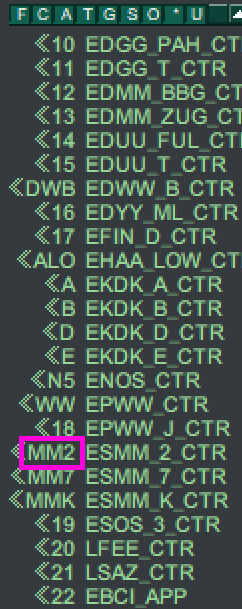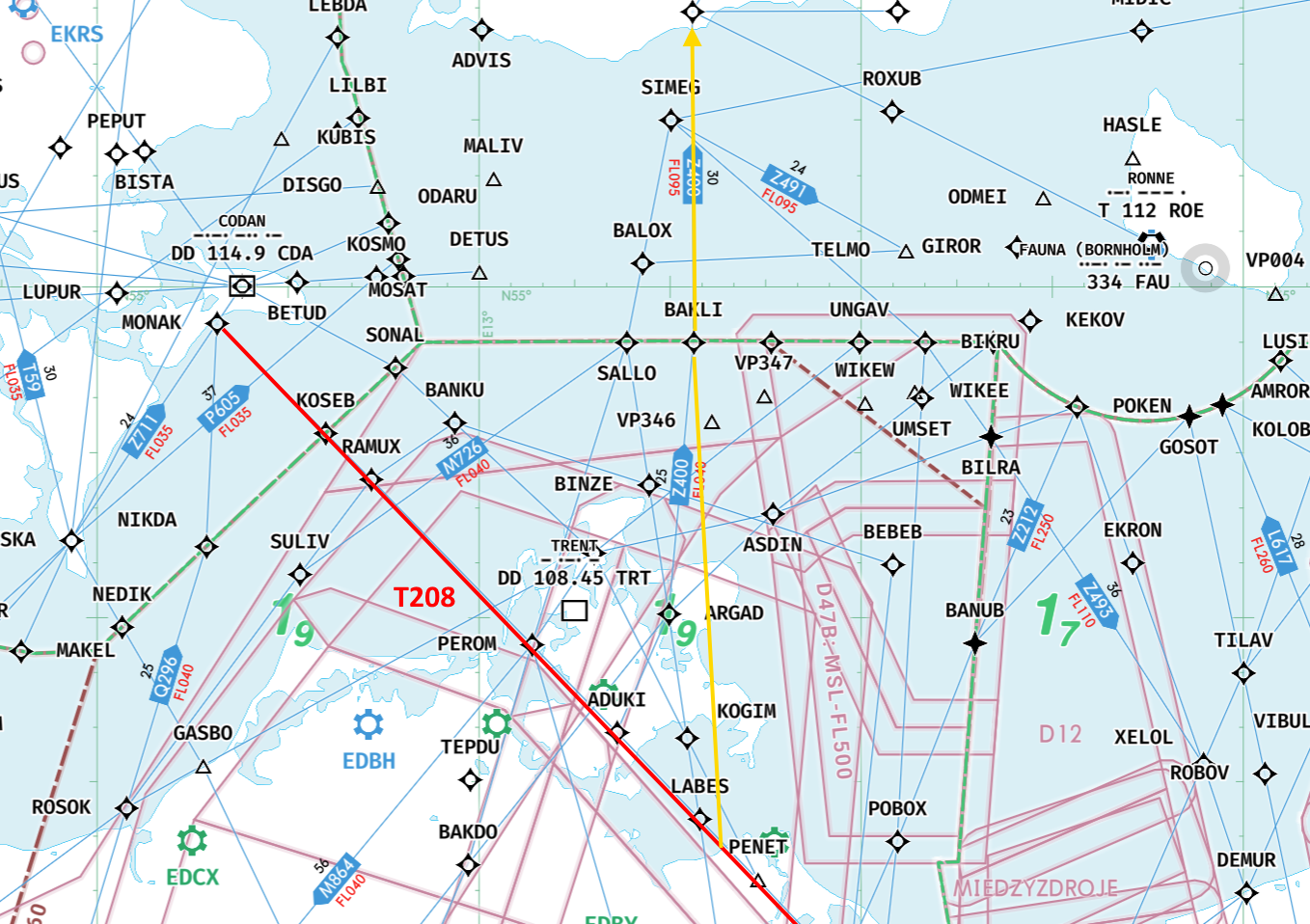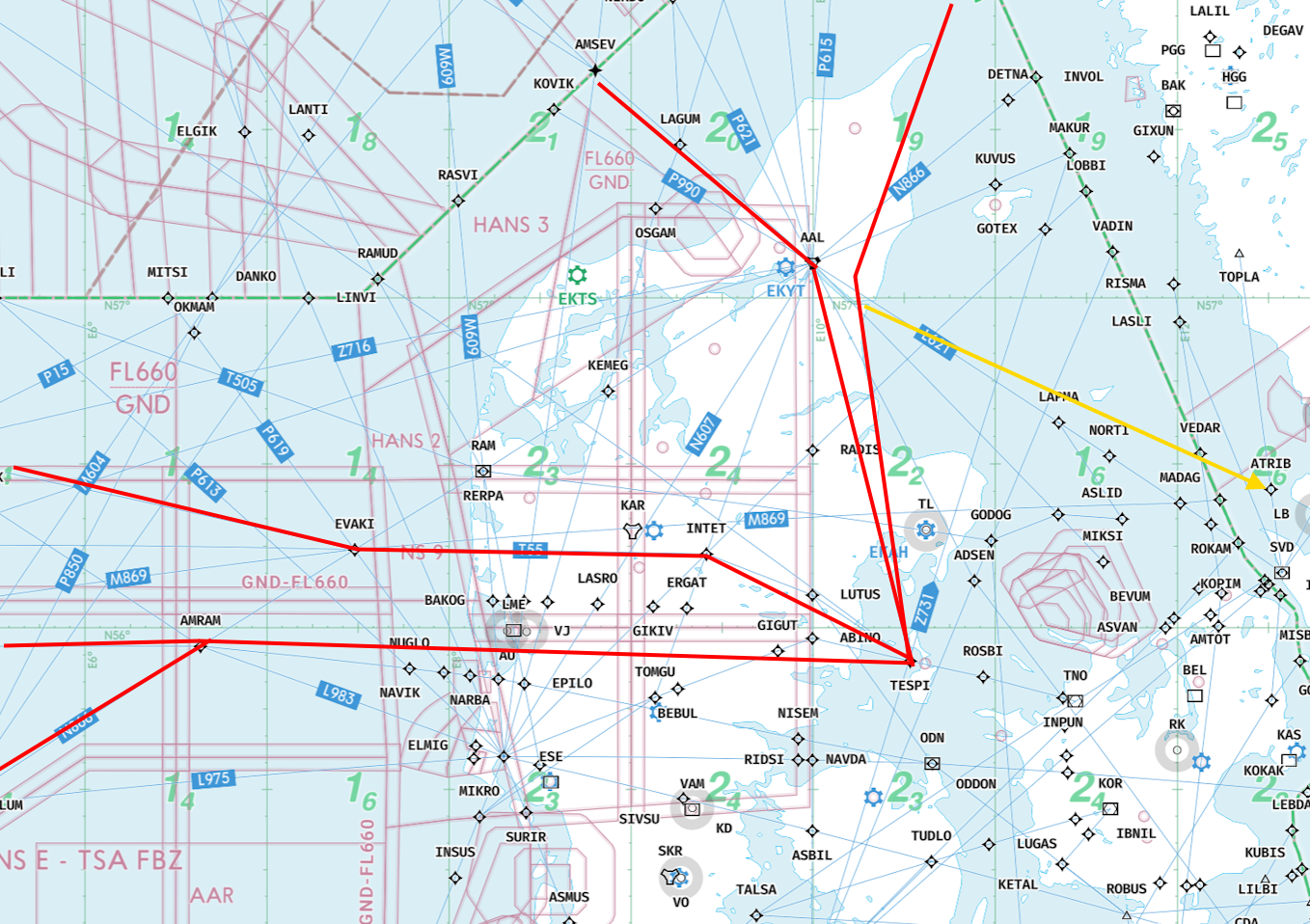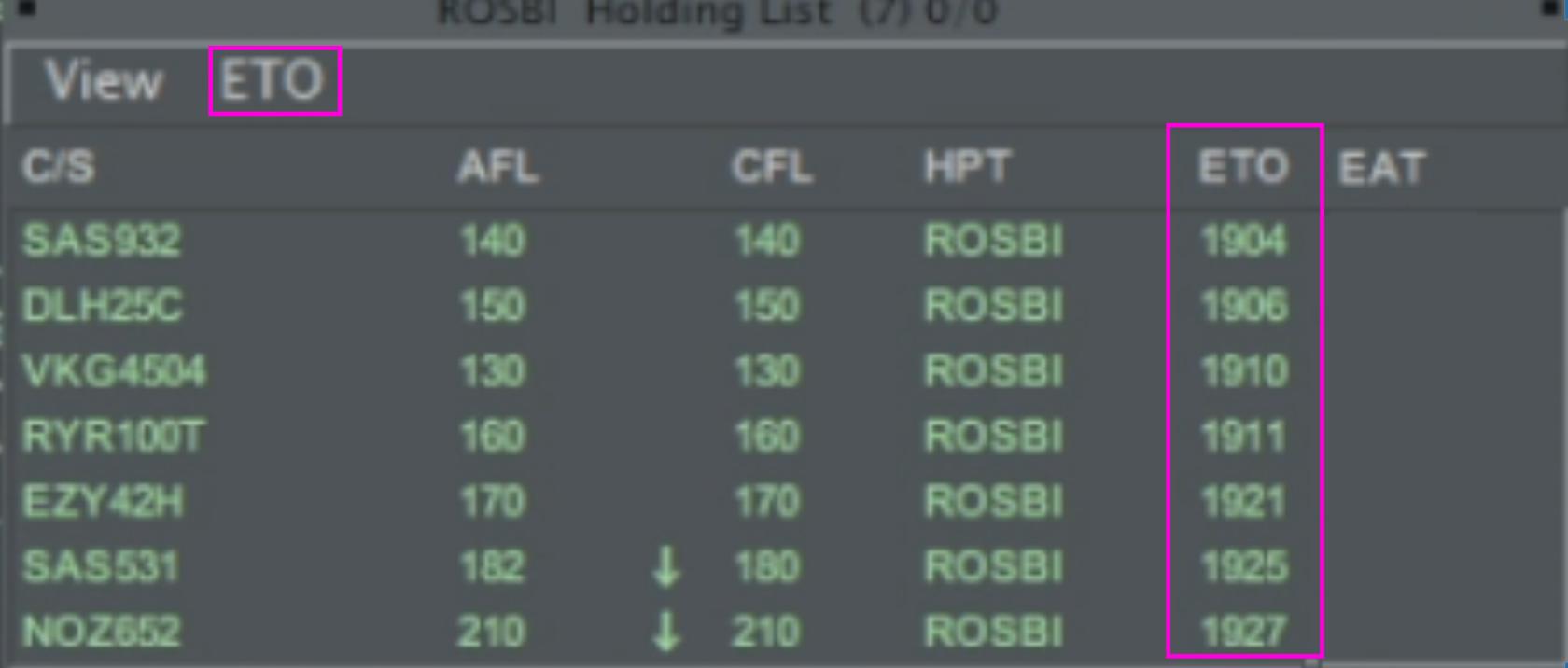Flow Management Position
For controllers subject to FMP, please see at the end of this page for abbreviated procedures you can expect.
ALB = Arrival Load Balancer. For tutorial of ALB see here
0. Setup
Before logging on make sure you do following steps in your Euroscope
- Load Profile DK_FMP
- Open a CTR ASR file
- Go to "Other Settings" and "Sector Ownership Setup" and take control of following sectors
- APP-E/W/N/S
- EKDK_B/I/D/E
- Your identifier er "FLOW"
- Make sure ALB is loaded as your plugin. write in ES command line ".alb open" to start the program.
1. Objective and Responsibilities
As Flow Manager (EKDK_FMP) Your objectives and responsibilities in the time period FMP active traffic flow is in sequence of succession:
- Establish Flow rates via ALB consistent with traffic demands.
- Chapter 2
- Manage flow inbound to copenhagen by use of the "BIDE" Acronym
- Balance
- Interrogate
- Distribute
- Equalize
- Modify the ACC sector allocation following traffic peaks
Details of how to achieve all is specified below and is continuously updated.
Please refer to this documentation every time before you log onto EKDK_FMP
2. Flow Rates into TMA
Adjusting the flow rate of aircraft handed over from the 5 ACC sectors (DK_E, DK_D, DK_B, MML, MMK) into TMA. They are managed and communicated via the ALB, and has several pre-defined scenarios.
2.1 Standard Separation (Green Flow)
This scenario used from the beginning of event until hourly rate becomes more than 30/hr.
Arrival rate 150 flights / hr
2.1.1 Required Rates
All ACCs have standard handovers as pr. LAI/LOA of 10nm with leading aircraft faster, or 5nm with leading aircraft fast if prior coordination has been obtained.
This is valid for all sectors.
2.1.2 Thoughts and considerations
This rate is being used when so little load will be on the TMA (smaller than 30/hr) that the distribution of flights are negligeble.
Either via manual calculations, ALB or MAESTRO, fine tuning of timings, and speed restrictions can be utilized with this rate. Neither are mandatory, but may make APPs use of vectors more efficient.
2.2 Reduced flow (Yellow Flow)
This scenario used from when ALB advise of an hourly rate of MORE than ~30/hr, but with TMA consitent load factor of less than 12 airplanes
Arrival rate 56 flights / hr
2.1.1 Required Rates
ALB has several scenarios for rates distribution based on the load factor for STARs.
Load factors are displayed in percent for the next 30 minutes.
The scenarios included are valid 95% of the time and are adjusted as follows:
2.1.2 Thoughts and considerations
Consider start negotiating with Upper ACCs in providing delay vectors in order to help achieving the required separation as early as possible
Invoke LOA point on EDYY and EDWW to increase separation to minimum 25nm.
2.3 Peak Flow (RedFlow)
This scenario used from when ALB advise of a TMA load of 12 or more AND 30flight/hr. or more inbound.
Arrival rate 45 flights / hr
2.1.1 Required Rates
ALB has similar scenarios for Peak flow as well. 12 or more planes in TMA signifies that TMA has reached capacity and immediately action is required to reduce flow rate to a level that is sustainable and comparative to what the TMA can land
The scenarios included are valid 95% of the time and are adjusted as follows:
2.1.2 Thoughts and considerations
Peak flow is still based of a relatively even distribution of flights, however as the evening progresses and the holds are filling up, it may be needed to move to the "STOP" scenario and move to individual release from holdings as described in point 2.5
3. Management
Use the Acronym BIDE to remember your tasks
3.1 "BIDE"
In addition to managing the flow rate, you need to manage different aspects of the night in regards to traffic. For an attempt to make it easier to remember the acronym BIDE can be used, to remember the four different areas you must manage.
- Balance
- Prioritise a specific STAR via the ALB when load is disproportionally heavy
- Interrogate
- Coordinate with various upper ACCs (DK_A, DK_N,DWM,YY) to achieve best flow
- Distribute
- Re-Route from East to West and West to East.
- Equalize
- Ensure that releases from holdings are consistent with who has been there the longest from each side
All is explained in Detail below
3.2 Balance
3.2.1. Balanced or prioritized flow
From the very beginning of the event you need to identify, via ALB or your screen a potential situation where you need to switch the vast majority of the flow to one STAR or Side, in order to avoid a total collapse on that sector.
Please note that:
- The state of imbalanced flow is so extreme that it should not be used for more than 15minutes.
- with 2 min / 10nm separation from the prioritized STAR you get 8 aircraft in in that time, meaning a hugely efficient thing.
- MAKE SURE the controller is using tight spacing
- Consider telling 10nm spacing, down to 7.5 pre-coordinated by you, in order to ensure lots of traffic gets is.
- If controller is NOT adhering to the tight spacing consider giving additional individual releases to balance things out.
3.2.2. ALB
This means that for PRIORITY STAR that:
- Prioritized STAR has 10nm /2min separation
- Tell ACC sector that 7.5nm is pre-coordinated by you with APP
- All other STARs on that side are STOP, however on WEST STREAM you have freedom to do individual release
- Priority TUDLO/TESPI has an hourly rate of ~36 an hour, meaning you can release ERNOV or TUDLO flights of ~2-3 airplanes during a 15 minute period to your liking depending on where its needed the most.
- For TUDLO/TESPI priority MONAK still release with 6min due to the perceived threat of a stop at MONAK
- This can be altered if required by you if required
This means that for PRIORITY O/W that:
- Priority W considers that TUDLO stream gets re-routed via Vectors to the east side for sequencing and general balancing.
- Priority-O will only be in case of light load on WEST stream and high load on BOTH MONAK and TIDVU STAR
- This would be a very rare phenomenon. For overloaded MONAK use "PRIORITY MONAK"
3.2.3 Thoughts and considerations
3.3 Interrogate
3.3.1 General
It is vital that you talk to the Upper ACCs both domestic and foreign to pre-sequence and help out your ACCs. These are in particular following things in order of importance based off experience and feedback.
- MONAK: Talk to DWM (Muritz sector) and get them to stack airplanes from FL200 up to FL270 when you see a potential overload situation.
- DO NOT rely on EKDK_B to do this as he will be busy
- DO NOT rely on DWM to do this as he will not have an overview of what is needed
- Establish Secondary holdings to stop flow into EKCH
- For TUDLO establish enroute hold at TALSA when no more entries towards EKCH is accepted by you
- For TESPI establish enroute hold at AAL when no more entries towards EKCH is accepted by you
- For MONAK, tell DWM (Muritz) that no more inbound are accepted at this time (15min-30min. notice required) and advise to establish an enroute hold as desired, or start diverting.
3.4 Distribute
3.4.1 General
This is about distributing flights to which arrivals, or more precise when to REdistribute arrivals to other STARs.
We want to have an ~55/45 split on EAST/WEST. You should consider distributing flights to other STARs when you:
- See an imbalance or empty STARs with other STARs full but no extreme enough to warrant a "Prioritized flow".
- A potential overload situation can happen on a STAR if immediate action is not taken
- Tactical distribution for reasons of your discretion
3.4.2 Techniques
Changing a STAR must ALWAYS adhere to the following.
- Ask the Sector which will get the aircraft to request a tactical direct to their sector
- Ask the sector to change the flightplan route to be only the point of the new STAR.
When coordinating a re-routing please strongly consider using the "point" command to make the controller aware by writing
- ".point [X]" click the aircraft to point out.
- X is the 1-3 letter Idenfier of the station you are coordinating with
- IMPORTANT: Do not use the callsgin (EDWW_M_CTR), use the 1-3 letter identifier (DWM) (found in controller list)

3.4.2 Recommended distribution changes
Following flights are highly effective an recommended
1. EDYY via MONAK - Distribute to TUDLO/TESPI
- Largest threat to the flow is the overload on MONAK. If you see a large amount entering via DWM (Muritz) take immediate action to get some of the GESKA arrivals from EDYY distributing to other STARs.
- Coordinate with DK_A to re-clear via Euroscope to either a vector or another point.
1. EDDH via MONAK - Distribute to TUDLO/TESPI
- EDDH flies at FL230 and hence creates all sorts of issues for DK_B. Consider distributing to TUDLO or TESPI depending on which STAR has the most space (Can be issues as an ECFMP as well)
- Consider whether to keep af FL230 or climb to FL290 to be distributed to DK_A
2. EDWW via MONAK from T208
- In a potential MONAK overload situation flights via T208 can be effectively rerouted to TIDVU for holding there. A good direct to propose is "BAKLI" as this is a valid point for the direction
3. ESMM via ERNOV - Distribute to TIDVU
- If high load persist on WEST STREAM and you want to get aircraft to EAST STREAM the most effective way is distributing ERNOV arrivals to TIDVU. This is especially ERNOV arrivals from ESSA and EFHK, as they have a good angle. Coordinate with ESMM
- This is preferable to distributing TUDLO arrivals to MONAK, as long as ESMM or similar is online.
- Avoid distributing ERNOV arrivals from ENGM via L996.
3. EKDK via TESPI - Distribute to ERNOV
- For extreme load on TESPI, consider distributing a few to ERNOV to keep hold managable. This is especially useful if you have high load from ENGM/ENBR combined with several flights crom EGPX
3.5 Equalize
3.5.1 General
This is to use ONLY when you also use the STOP function in ALB, to switch to individual release
This is a useful feature when you have lots of stacked holdings everywhere, and we need to release people as they entered.
As EKDK_FMP you should have all 5 holdings opened, when in use
For each side you must identify who has been in holding the longest by identifying the ETO in the holding list
Ensure you have the holding sorted in ETO
3.5.2 Logic
Your logic must be to release a certain amount of aircraft from one hold before then releasing a certain amount from another hold.
Aircraft must be released with the rate given in ALB!
In this example you have the three holdings on WEST STREAM, and you are individually releasing from ETO. Make following observations
- LUGAS has the oldest time at 0753
- ROSBI has an aboudance of planes in the holding
- ERNOV only has a few ones, and is not worth too much effort
3.5.3 Method
For this scenario we will keep the ERNOV EAT at 10min for simplification, but if a large holding persist at ERNOV it must also be included
In this scenario its a standard "RED" meaning 6min. from each of the TUDLO/TESPI STARs
- Identify oldest airplane BAW816
- Release all airplanes up until the first one which is later than the oldest of the next STAR
- In this case SAS78C is 0757 and SAS2856 is 0756, meaning SAS78C is the last to be released
- Tell EKDK_D_CTR to release all airplanes up to and including SAS78C and ask him to Highlight SAS78C
4. Tell EKDK_E_CTR the EAT of SAS2856. The time is "08:00"... two planes are released with 6 min apart meaning EAT for SAS2856 is 0812. ask him to write that in the holding list
5. Tell EKDK_E_CTR that after SAS2856 to release everybody with the rate until SAS445 (0803) to the revert back to D_CTR to release SAS031 and BAW822 respectively
5. EKDK_D will release SAS031 and BAW822 as point 3-5, back to DK_E who will release until DLH33, and then it head back to DK_D-
6. MMK will meanwhile release at EATs you are specifying. The rate takes into consideration an ERNOV every 10 minutes, so delay for an appropriate gap
- In this scenario consider releasing an ERNOV every time you switch, aka release
- ETH728 after DLH33)
- SAS1429 after SAS2165
Use your best judgement and logic
3.6 Sector Distribution
3.6.1 Four-way east split
By default, the following ACC sectors are staffed:
- EKDK B
- EKDK D (assumes I)
- EKDK E
- EKDK UC (assumes A/C/UA)
If the departing traffic load through sector I is heavy, and the controller managing D sector faces an overload, the UC controller can assume I sector in addition to all upper sectors, by selecting the EKDK A frequency (135.290).
3.6.2 Three-way east split
Alternatively, when 3 controllers are available, the BIDE area is split as follows:
- EKDK B (assumes I)
- EKDK E (assumes D)
- EKDK UC (assumes A/C/UA)
If the traffic flow thorough any of the BIDE sectors is too high, the UC controller can assume sector I as above, or sector D by selecting the EKDK C frequency (128.215).
Any sector swapping measures must be communicated to APPCO and Bremen/Maastricht. Ensure that the standard UC frequency remains cross-coupled throughout any sector swap.











